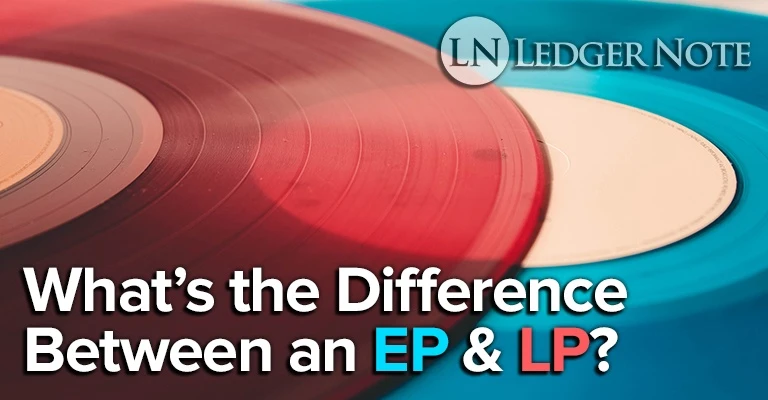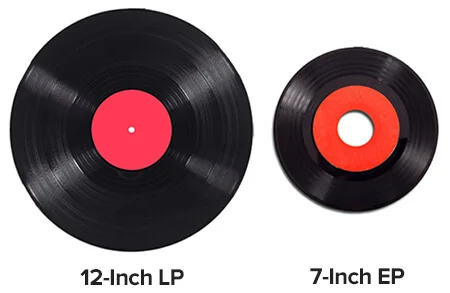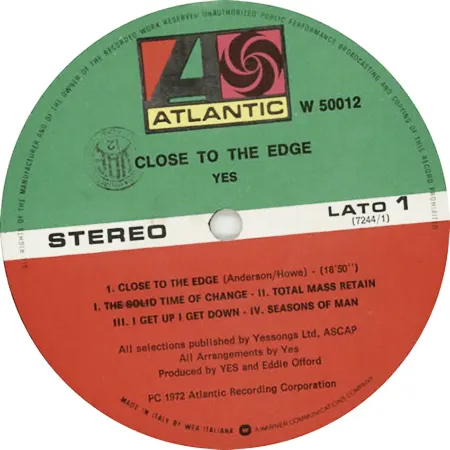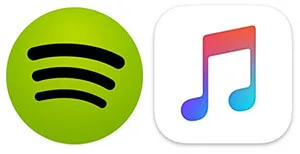
What’s an EP? And how is it different from an LP? This is a question that comes up all the time from aspiring musicians and fans alike, and the answer is not quite as simple as you might think! Let’s explore some of the differing qualities between EPs and LPs, the history behind these two album formats, and how they might help you if you’re looking to further your career in music.

What’s the difference between an EP & LP album?
As a casual fan or curious listener, you might just want the quick answer, but for anyone involved in the music industry, you’ll want all the details, because choosing whether to release an EP or an LP requires taking multiple factors into consideration, such as budget, time constraints, creative process and desired career trajectory.
To really understand the difference between an EP and an LP, it’s necessary to dig into the history of the music industry. It’s really quite interesting to see how the invention of a tangible product like the phonograph record would go on to shape the way people create and experience music for decades to come.
We’ll take a closer look at that history, but let’s get past the surface-level stuff first so we’re all on the same page. Then we’ll get into the nitty-gritty and how you can take advantage of these two formats. Nowadays, EPs exist for a very tactical purpose, but it all started with vinyl records.

Everything you need to know about LPs in music
What DOES LP short for?
LP stands for ‘Long Play’ or ‘Long Playing’.
What is an LP?
In the simplest terms, an LP is synonymous with a full-length album.
What is the origin and history of LP albums?
LP records were developed by the American record label, Columbia Records, in 1948. At the time, the industry standard was a 12-inch record that played at 78 rpm, allowing for only 5 minutes of audio per side. Columbia’s newly introduced LPs played at a reduced speed of 33.3 rpm, significantly increasing the audio capacity of a 12-inch phonographic record.
LP records were initially used for motion picture (movie) soundtracks that had previously struggled with the limitations of short, 78 rpm records. Eventually, LPs became more widespread, and the popularity of this format gave rise to the album era – a 50-year period during which full-length albums dominated the music industry. To this day, it is expected that artists should create music to fulfill the format of a full-length album.
How long is an LP?
Originally, a 12-inch LP record could hold about 23 minutes of high-quality audio per side. This generally meant that an LP consisted of 10-12 songs, with each song averaging 3 to 3.5 minutes in length. A full LP album would therefore range from 30-45 minutes in duration.
Even as music has progressed from records to cassette tapes to compact discs to online streaming, artists have continued to release full-length albums of 10-12 songs, which reflect the capacity of LP records.
Everything you need to know about EPs in music
What DOES EP short for?
EP stands for ‘Extended Play’.
What is an EP?
An EP typically refers to a mini-album or half-length album. It may seem counterintuitive for an extended play record to be shorter than a long play record, but EPs are extended in comparison to single releases.
What is the origin and history of EP albums?
EPs partially came about as a competing vinyl record format. In response to the LP record developed by Columbia Records, RCA Victor created a 7-inch record that played at a speed of 45 rpm, holding 7.5 minutes of audio per side.
EPs were first used to distribute compilations of singles, as well as album samplers. Due to the ability of record players to use different speeds and the success of Elvis Presley’s 28 EPs, and EP albums by Walt Disney containing the song and story recordings, the EP record gained a foothold in the industry and remained popular even as cassette tapes and CDs were introduced.
How long is an EP?
An EP can vary greatly in length. As a rule of thumb, an EP record is longer than a single and shorter than an LP/full-length album. Although there are outliers, the general expectation seems to remain that an EP’s length is somewhere between 3 to 6 tracks and 15 to 30 minutes long.
Why release an EP?
There are several reasons artists opt for this format, including a budget, marketing, and fan engagement. EPs are significantly cheaper to produce than full-length/LP albums, and they are also less time-consuming for the artist, as they require fewer tracks. EPs have also been used to promote an upcoming, full-length album, or to introduce listeners to a new style that the artist hopes to adopt. Beyond that, EPs serve to keep fans engaged in the periods between the release of full-length albums.
EP vs. LP: A summary
| LP | EP |
| LP in music means ‘Long Play’ and is a full-length album. | EP in music means ‘Extended Play’ and is a half-length or mini album. EP is extended in the sense that it’s longer than a single. |
| The original 12-inch LP record could store 45 minutes of audio. | A typical EP was a 7-inch record that could store 15 minutes of audio. |
| Full-length LP albums dominated the industry for years and listeners are familiar with the format. | EPs are more versatile, they can be mini albums, compilations, or singles with remixes. |
| LPs are expensive and time-consuming to produce but can yield greater results in terms of awards and recognition. | EPs require less commitment to create and work well to keep fans engaged in the era of online streaming. |
Hopefully, you now have a better understanding of what makes an EP versus an LP. Although the original definitions of LP & EP were based on the physical specifications of vinyl record diameters and playing speeds, the labels have since come to represent the number of tracks and length of audio recording.
However, in the current landscape of music, even these time frames and track numbers don’t really matter. Kanye West just released several albums that could be called EP’s but aren’t. Artists are thrusting off the constraints and letting creativity reign supreme.
Even back then, bands were already breaking conventions. As an example, when the progressive rock band Yes released their album “Close to the Edge” in 1972, it contained only three songs. So is it an EP? Well, the first track is over 18 minutes long and takes up an entire side, and the entire play time is 36 minutes and 25 seconds.
So, with the caveat that assigning albums as EPs or LPs is far from straightforward, how can these formats be used to further your music career?
5 ways artists use EPs today
The real question is why would artists and labels choose to release EPs at all? We briefly mentioned some of the reasons that artists might opt to create an EP, such as budget and marketing, but let’s take a closer look at the advantages of the EP album format.
1) Maintaining a release schedule
Growing your audience of listeners is important, but so is maintaining and engaging the loyal fans that you’ve already attracted. One way to do that is to have a predictable and reliable release schedule for new music. Sometimes, you may not have enough material ready or want to keep your fans interested by using “B-side” songs.
You can market these releases to your enthusiastic fans without worrying too much about exposing new listeners to material that doesn’t represent your best efforts. EPs are cheaper to record, produce, and promote to your existing audience. This keeps your fan base captivated until your next big album comes out or you embark on your next tour.
2) Fulfilling an Undesirable Contract
There have been cases where artists might sign, for example, a three-album deal with a record label. For whatever reason, if things aren’t working out and you want to escape the contract. You can release EPs as a means of fulfilling your side of the deal.
That usually means new music, but in some cases, it can be a single accompanied by a set of remixes created by other artists, a ‘Best of’ compilation, acoustic versions of popular songs, or any other creative means to escape the contract without sullying your discography.
3) Using the Format as a Pre-Studio Release
Rappers do this, but they call them mixtapes instead. The idea is that you can go ahead and create music for the purpose of a promotion or keeping fans satisfied, and in the future, they’ll be considered independent releases and separate from your debut studio album.
A big part of marketing is having a string of successful studio albums. In this way, EPs can serve as a tool for expressing creativity, providing existing fans with new music and reaping the benefits of consistent output, all while maintaining your spectacular record for only producing exceptional albums.
Rappers will create tons of mixtapes and take the best of those songs, repurposing them to use on their studio albums. It’s a great way to test out what fans think of your music before spending the money on marketing and expensive studio time trying to gain new listeners.
4) Marking a transition between full-length albums
You’ll laugh, but the masters of this strategy are Insane Clown Posse. Every album that they release has a theme and could be considered a concept album (their entire discography is a concept!), but between albums, they will release an EP that introduces their listeners to the theme and style of the next full-length album.
This approach allows ICP to evolve artistically, slowly introducing fans to their new sound and adjusting their expectations. It also keeps their raving fan base excited and occupied. The music on these EPs can be new songs, tracks from the cutting room floor that didn’t make it onto the previous album, or anything else.
5) Sharing favorite tracks that didn’t fit in with the style of the album
Albums tend to have consistent sonic characteristics or address specific emotional themes. Sometimes, you might write and record amazing songs that deserve to be heard but, for whatever reason, don’t fit in with the rest of the music that you’ve created for a project. A great way to share these tracks is through the EP format.
One example of this practice comes from Tech N9ne, who is famous for “never wasting a song.” He has said that he releases every song he ever records, and if you look at his discography, you’ll believe it based on his monumental output. Much of this consists of EPs that exist for the reason that they didn’t fit on any previous albums.
What qualifies as an EP in the current music distribution landscape?
Now that we’ve covered some of the reasons why you might release an EP or mini-album, you need to understand what qualifies as an EP these days when it comes to online streaming. Today, the majority of artists release their music through streaming platforms such as Spotify, Apple Music, Pandora, Tidal and countless others.

So, what defines an EP for each of these platforms? Let’s focus on the big two: Spotify and Apple Music. The reason why it’s important to be aware of the parameters of an EP is that Apple Music will actually add the “EP” label to your release if you meet their conditions, even if you don’t want it. Similarly, Spotify will place your release down at the bottom of your discography page under “Singles” rather than under “Albums.” Depending on your goals, it can be beneficial to be aware of these definitions.
What is an EP on Apple Music?
If your album meets either of the following requirements, it will be considered an EP:
- The release includes 1 to 3 tracks total, with one or more of these tracks being 10 minutes or greater in length, and the entire release is under 30 minutes in duration.
- The release includes 4 to 6 tracks and the entire release is under 30 minutes in duration.
Your album will automatically have “EP” added to the title if you meet these criteria.
What is an EP on Spotify?
Your release will be classified under the EP category if both of the following conditions are met:
- The release is less than 30 minutes in duration.
- The release has 4 to 6 tracks in total.
On Spotify, your album title will not be changed, but it will be placed in the separate “Singles” section below the “Albums” section of your discography.
Is it better to release a full-length album or an EP?
The truth is, these definitions of EP vs LP album formats are constantly in flux and have been changing nearly every decade since the vinyl record was invented. Try to worry less about the technical aspects and instead put thought into how you can use these different formats as part of your music marketing plan.
In today’s digital age, the suggested running time for an EP versus an LP is slowly being disregarded. Many artists are releasing albums of increasing length, while others are opting for shorter ones. Some are releasing only singles, as is often seen in the electronic genre. The idea of a specific number of tracks is becoming a thing of the past.
Here at LedgerNote, we would suggest using the nomenclature of an EP as a tactical marketing strategy. Use it to keep your “studio album” discography pristine and perfect. Release anything not suited for your full length albums as an EP or compilation so you can keep feeding your fans what they want. That way, when you’re ready to drop your next big LP, your fans will have been following along and they’ll be itching to see you on tour.